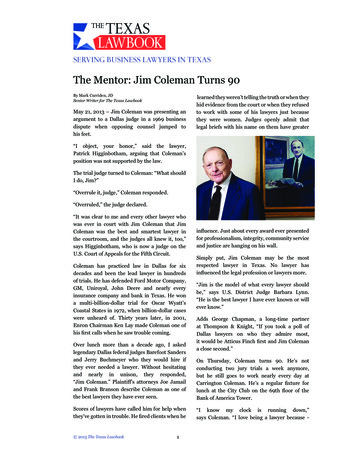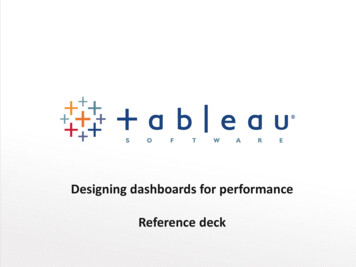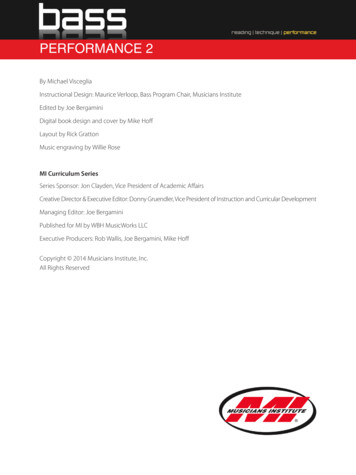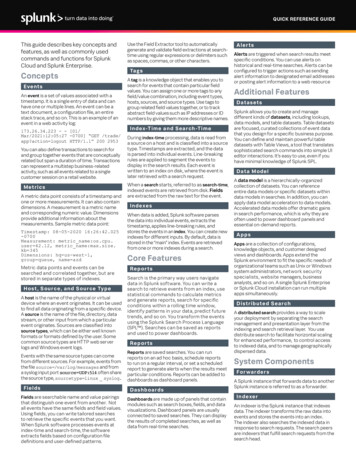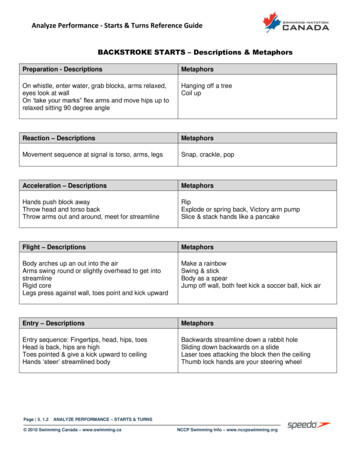
Transcription
Analyze Performance - Starts & Turns Reference GuideBACKSTROKE STARTS – Descriptions & MetaphorsPreparation - DescriptionsMetaphorsOn whistle, enter water, grab blocks, arms relaxed,eyes look at wallOn ‘take your marks” flex arms and move hips up torelaxed sitting 90 degree angleHanging off a treeCoil upReaction – DescriptionsMetaphorsMovement sequence at signal is torso, arms, legsSnap, crackle, popAcceleration – DescriptionsMetaphorsHands push block awayThrow head and torso backThrow arms out and around, meet for streamlineRipExplode or spring back, Victory arm pumpSlice & stack hands like a pancakeFlight – DescriptionsMetaphorsBody arches up an out into the airArms swing round or slightly overhead to get intostreamlineRigid coreLegs press against wall, toes point and kick upwardMake a rainbowSwing & stickBody as a spearJump off wall, both feet kick a soccer ball, kick airEntry – DescriptionsMetaphorsEntry sequence: Fingertips, head, hips, toesHead is back, hips are highToes pointed & give a kick upward to ceilingHands ‘steer’ streamlined bodyBackwards streamline down a rabbit holeSliding down backwards on a slideLaser toes attacking the block then the ceilingThumb lock hands are your steering wheelPage 5. 1.2ANALYZE PERFORMANCE – STARTS & TURNS 2010 Swimming Canada – www.swimming.caNCCP Swimming Info – www.nccpswimming.org
Analyze Performance - Starts & Turns Reference GuideBACKSTROKE STARTS – Challenges, Root Causes & FixesPreparation – Common ChallengesRoot CausesFixesDifficulty reaching barSwimmer too small for size of blockSwimmer may grab pool edge or move feet higherReaction – Common ChallengesRoot CausesFixesFeet slipping down wallFeet not placed well on wallHave swimmers ‘spread toes’ to grip, or stagger feetBody drops back down, instead of up & backLegs not activated to keep hips upAcceleration – Common ChallengesRoot CausesFixesLetting go of block with no power in armsNo flexion/tension to create powerBreak down start to just the pull up (reaction) and thenjust ‘jump’ up to see if they can activate armsPractice on dryland firstEyes continue to look at block, headnot tilted backFlight – Common ChallengesRoot CausesHips drag through water, body is not straightSwimmer hasn’t pushed hips high or As above but to a ‘sit jump’ then progress to back startshad enough power in legswith a noodle they have to go overEntry – Common ChallengesRoot CausesFixesHead is up, hands are apart and feet maydrag through the waterCan’t see where they are going so‘sit’ more in the diveWatch their hands go back into entry to fix head andhold hand over water to provide visual cue of wherefeet are to ‘kick’ at the endFixesPage 5.1.3 ANALYZEANALYZE PERFORMANCE – STARTS & TURNS 2010 Swimming Canada – www.swimming.caNCCP Swimming Info – www.nccpswimming.org
Analyze Performance - Starts & Turns Reference GuideTRACK STARTS – Descriptions & MetaphorsPreparation – DescriptionsMetaphorsOne foot forward at front edge of block, other behindFront leg relaxed, back leg bent-balancing on ball offootArms hanging down and gripping front edge of blockHead down, eyes look downLike sprint runners, front toes like fingers ‘holding’blockSame line as wallWatching handsReaction – DescriptionsMetaphorsMovement sequence: Hips, head, legs & armsBack & neck extend forward, head aimed to waterPush back on block with hands simultaneously withrear foot drivePop, move outPower outAcceleration – DescriptionsMetaphorsArms thrown forward, under and outExplode with rear leg, then drive with front legReach. Throw your arms to the other end of the pool.Explode, powerFlight – DescriptionsMetaphorsBody parallel then angled to water surface to entryHead & spine in line, moving forwardArms align head & torso – rigid coreOut and downLike a planeLike a spear, in streamline positionEntry – DescriptionsMetaphorsSequence of entry, arms, head, torso, hips, legsHead in neutral position, locked in arms at entryFeet together, toes pointedHands ‘steer’ streamlined bodyLike a hand going into a gloveStraight as an arrowLike a rudder of a boat, hands will lead the way.Page 5. 2.2ANALYZE PERFORMANCE – STARTS & TURNS 2010 Swimming Canada – www.swimming.caNCCP Swimming Info – www.nccpswimming.org
Analyze Performance - Starts & Turns Reference GuideTRACK START – Challenges, Root Causes & FixesPreparation – Common ChallengesRoot CausesFixesUnbalanced on blockEyes looking forwardFeet might not be placed far enoughapart or may have straight kneesProgression from side to blocksProper placement of feet with bent kneesReaction – Common ChallengesRoot CausesFixesHave initiated movement upwards insteadof forwardHave let go of the block and liftedhead upwardsKeep eyes directed downward (cue look at big toe) anddirect swimmer to push against the block with hands tobeing forward movementAcceleration – Common ChallengesRoot CausesFixesArms do not reach full extensionMay not have pushed hard enoughwith the legs to generate enoughforce and fallen in too soonProvide a visual cue on the bottom of pool to help‘point’ their hands/arms in the right directionFlight – Common ChallengesRoot CausesFixesKnees bent and legs not higher than hips orone leg stays higher than other, not togetherNot enough force generated fromthe legs, or one leg pushes harderthan the other legVarious jumping exercises on land & side of pool firstThen try holding a soft noodle for them to dive over as aguideEntry – Common ChallengesRoot CausesFixesBody not on proper angle (too flat)Head up and hands may be apartNot enough force off block (legs)Looking up not down, hands not inlocked streamline positionProvide visual cue of where you want the swimmersentry point to be and remind of locked hand positionPage 5.2.3 ANALYZEANALYZE PERFORMANCE – STARTS & TURNS 2010 Swimming Canada – www.swimming.caNCCP Swimming Info – www.nccpswimming.org
Analyze Performance - Starts & Turns Reference GuideGRAB STARTS – Descriptions & MetaphorsPreparation – DescriptionsMetaphorsBoth feet forward with toes curled over edge of block,shoulder width apartFingers grasp block between toesHead down and eyes looking backKnees slightly bentSnap. Grip the block with toes like an eagle grabbingthe branch of a tree.Fold down. Head down, butt up. Look between yourlegs.Reaction – DescriptionsMetaphorsArm/back muscle flexion & draw hips forwardLegs flex and contribute to drive moving centre ofmass forwardMovement sequence: Torso, arms, legsCrackleMove outAcceleration – DescriptionsMetaphorsThrow arms forward after tension & flexionStreamline with head hidden by armsArms and head in line with body to direct all forces inlinear directionPop, explodeSqueezeFlight - DescriptionsMetaphorsBody parallel then angled to water surface to entryHead and spine in line, moving forwardArms align head & torso – rigid coreJumpLike a planeLike a spearEntry - DescriptionsMetaphorsSequence of entry, arms, head, torso, hips, legsHead in neutral position, locked in arms at entryFeet together, toes pointedHands direct streamlineDive into holePoke a hole in the water with fingertips then slidebody throughStraight as an arrowLike a rudder of a boat, hands will lead the way.Page 5. 3.2ANALYZE PERFORMANCE – STARTS & TURNS 2010 Swimming Canada – www.swimming.caNCCP Swimming Info – www.nccpswimming.org
Analyze Performance - Starts & Turns Reference GuideGRAB START – Challenges, Root Causes & FixesPreparation – Common ChallengesRoot CausesFixesUnbalanced on blockEyes looking forwardFeet might not be placed farenough apart or may have lockedknees/straight legsProper placement of feet with bent kneesNo slip grip, cuing of foot placement at shoulder widthapartProgress from side of pool to starting blockReaction – Common ChallengesRoot CausesFixesHave initiated movement upwards instead offorwardHave let go of the block and liftedhead upwardsKeep eyes directed downward and direct swimmer topush against the block with hands to being forwardmovementAcceleration – Common ChallengesRoot CausesFixesArms do not reach full extensionMay not have pushed hard enoughwith the legs to generate enoughforce and fallen in too soonProvide a visual cue on the bottom of pool to help‘point’ their hands/arms in the right directionFlight – Common ChallengesRoot CausesFixesKnees bent and legs not higher than hipsNot enough force generated fromthe legsVarious jumping exercises on land & side of pool firstThen try holding a soft noodle for them to dive over as aguideEntry – Common ChallengesRoot CausesFixesBody not on proper angle (too flat)Head up and hands may be apartNot enough force off block (legs)Looking up not down, hands not inlocked streamline positionProvide visual cue of where you want the swimmersentry point to be and remind of locked hand positionPage 5.3.3 ANALYZEANALYZE PERFORMANCE – STARTS & TURNS 2010 Swimming Canada – www.swimming.caNCCP Swimming Info – www.nccpswimming.org
Analyze Performance - Starts & Turns Reference GuideBUTTERFLY TURNS – Descriptions & MetaphorsApproach - DescriptionsMetaphorsStretched out, straight arms, not lockedEyes downHips at surfaceSimultaneous two-hand touchLong, tallHide your headBum up!“T T” Touch together!Turn - DescriptionsMetaphorsKnees & feet slide under stomach asone hand leaves wall, elbow pulls straight backunderwaterAs feet plant on wall, 2nd hand brushes past headwith elbow pointing to surfaceHands meet overhead ready to streamlineGoal: have heels, hips, head & hands in same lineSlide along a shallow imaginary glass bottomStarting a lawn mowerElbow someone, then shoot (all in fun mind you!)Fashion model, brush your hair with hand combCover eyes from bright sun!Catch, slap or glue handsLying down on the floorPush Off - DescriptionsMetaphorsHand over hand with top thumb wrapping aroundbottom hand for tight arm streamlined push-offEyes directed to bottom, head locked in armsPush-off slightly on side over to stomach at fullextension when feet leave the wallLock handsSqueeze ears/headLook for pennies!Log roll, torpedo, blastGlide – DescriptionsMetaphorsStreamlinedFeet together for dolphin kickingLong strong dolphin!Whale tailTransition - DescriptionsMetaphorsMetaphorBlast out!Break out!Fly out!Hands start first swimming stroke as head breakssurface of waterPage 5.4.2 ANALYZE PERFORMANCE – STARTS & TURNS 2010 Swimming Canada – www.swimming.caNCCP Swimming Info – www.nccpswimming.org
Analyze Performance - Starts & Turns Reference GuideBUTTERFLY TURNS – Challenges, Root Causes & FixesApproach – Common ChallengesMisjudged timing into wallHips and feet too lowOne-handed touchesRoot CausesLack of experience of timing touchFatigue (swimmer not ready for a 50 fly)Lack of up-kick on stroke, tiredWanting to turn too quicklyFixesUse the T on bottom or ‘flag area’ to count strokes tohelp to shorten/lengthen strokes prior to touch4H – High head, hips, heels as you touch!Eyes directed to wall in order to see hands touchTurn – Common ChallengesSwivelling like a spinning top, vs. a car tireFeet planted too low on wallRoot CausesBoth hands leaving wall at the sametime and swing together to same sideLegs too low in the approach and alack of tuck during turning actionFixesOn deck practice ‘karate’ move (arm back), break itdown to parts while standing in shallow waterPractice going from front float (mid-pool) and pullarms/legs in at same time, to feel backspinPush Off – Common ChallengesHands slide apart as they push-offArms bent (‘ploughing’ on push-off)Eyes looking forward, lifting head upPushing off at the surface, lack of depthRoot CausesHands stacked too lightlyLoose streamlineInefficient streamlineFeet planted too low on wall or perhapsnot enough air taken in during turnFixesShow strength of the thumb lock on deck or standingin shallow water, will also help straighten armsPlace visual cues along bottom to keep head downPulling knees into body for tight tuck, helps feet gethigher on the wall –aim feet for ‘T’ markGlide – Common ChallengesHands apart and/or arms bentFeet not kicking together, flutter kicksGliding at the surface, vs. underwater glide,which shortens distance glide is heldRoot CausesHands not locked for streamlineFeet too far apart, used to flutter kickFeet placement on wall (lack of tuck) &no slight chest press to hold glideFixesThumb lock as aboveRemind kids to touch big toes before they start kickPractice just push-offs, outside of a set so fatiguedoesn’t affect distance for glideTransition – Common ChallengesKeeping enough speed up into first strokeRoot CausesMay be too deep or trying to do toomany kicks off wallMay be looking forward & lifting heador pushed off too deepFixesLimit number of kicks off wall & try to do first strokewith no breath, to keep a low profile into first strokeWork on push-off angle and glide outside of a set tohelp concentrate on this first breakout strokeBody position too vertical – difficult to getarms out of the waterPage 5.4.3 ANALYZE PERFORMANCE – STARTS & TURNS 2010 Swimming Canada – www.swimming.caNCCP Swimming Info – www.nccpswimming.org
Analyze Performance - Starts & Turns Reference GuideBACKSTROKE TURNS – Descriptions & MetaphorsApproach - DescriptionsMetaphorsCorrect strokes counted so that last recovery armcrosses over body onto stomach for free pull into turnas the last back pull is taken below surfaceFree pulling arm must continues to pull under body(as chin tucks) ready for turn#, #, # over-pullHide your head/bury your head“Just keep pulling” (. if they‟ve seen Finding Nemo!)Turn - DescriptionsMetaphorsOne dolphin kick allowed as thighs coil into bodyToes point as they leave water and go towards wallThe last pulling arm continues down & pull back, untilit meets the trailing arm, ready for streamlineTurn is oval shaped somersault.Feet plant on wall below the surface, at least 20-30cm down the wallGoal: have heels, hips, head & hands in same lineMake a ball fast!Fast feet (pointing toes helps do this)“Just keep pulling!”Bum at 12 o‟clock, head at 6 o‟clockIron arms, catch, slap or glue ha
Break down start to just the pull up (reaction) and then just ‘jump’ up to see if they can activate arms Practice on dryland first

